
Kuih are bite-sized snack or dessert foods commonly found in Southeast Asia. It is a fairly broad term which may include items that would be called cakes, cookies, dumplings, pudding, biscuits, or pastries in English and are usually made from rice or glutinous rice. The term kuih is widely used in Malaysia, Brunei, and Singapore, and kueh or kue is used in Indonesia, to refer to sweet or savoury desserts. Though called by other names, one is likely to find various similar versions of kuih in neighbouring countries, such as Vietnam, Thailand, and Myanmar. For example, the colourful steamed kue lapis and the rich kuih bingka ubi are also available in Myanmar, Thailand, and Vietnam. In the Philippines, kuih are referred to in Tagalog as kakanin.
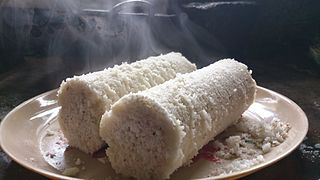
Pittu or puttu is a breakfast dish eaten in the South Indian states of Kerala, Tamil Nadu and parts of Karnataka, as well as Sri Lanka. Puttu means "portioned" in Malayalam. It is made of steamed cylinders of ground rice layered with coconut shavings, sometimes with a sweet or savory filling on the inside. Puttu is served hot with sweet side dishes such as palm sugar or banana, or with curries such as dal, chickpea, mutton, fish or chicken. In Bhatkal, puttu is served with side dishes such as ghee and sugar or Paya.

Appam is a South Indian pancake dish, made with fermented rice batter and coconut milk, common in the South Indian states of Tamil Nadu and Kerala, as well as the island nation of Sri Lanka. It can be made and served in both sweet and savoury varieties, with the centre of the appam having either a creamy, coconut milk layer or a sunnyside up-style fried egg. Appam is usually served for breakfast or dinner.

Pisang goreng is a snack made of banana or plantain, covered in batter or not, being deep fried in hot cooking oil, and is popular in Indonesia, Malaysia, Singapore, and Brunei.

A rice cake may be any kind of food item made from rice that has been shaped, condensed, or otherwise combined into a single object. A wide variety of rice cakes exist in many different cultures in which rice is eaten, and are particularly prevalent in Asia. Common variations include cakes made with rice flour, those made from ground rice, and those made from whole grains of rice compressed together or combined with some other binding substance.

Kue is an Indonesian bite-sized snack or dessert food. Kue is a fairly broad term in Indonesian to describe a wide variety of snacks; cakes, cookies, fritters, pies, scones, and patisserie. Kue are made from a variety of ingredients in various forms, some are steamed, fried or baked. Kue are popular snacks in Indonesia, which has the largest variety of kue. Because of the countries' historical colonial ties, Koeé (kue) is also popular in the Netherlands.
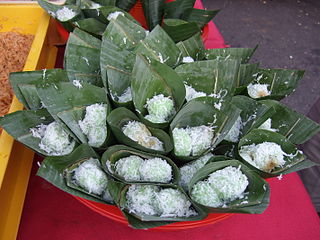
Klepon, or kelepon, is a traditional Southeast Asian green-coloured balls of rice cake filled with liquid palm sugar and coated in grated coconut, originating from Indonesia. The sweet glutinous rice balls is one of popular Indonesian kue, and it is commonly found in Indonesia, Malaysia, Brunei and Singapore.

Serabi, also called surabi, srabi, also known in Thailand as khanom khrok, is an Indonesian pancake that is made from rice flour with coconut milk or shredded coconut as an emulsifier. Most of traditional serabi tastes sweet, as the pancake is usually eaten with kinca or thick golden-brownish-colored coconut sugar syrup. However, another savoury version also existed that uses oncom toppings. Different provinces in various Asian countries have their own serabi recipes corresponding to local tastes.

Kue cubit is a Southeast Asian snack, originating from Indonesia. It is common snack food served in many Indonesian cities. It is a cake, around 4 centimetres (1.6 in) in diameter. The sellers of this snack usually operate near schools or traditional markets. Kue cubit uses flour, baking powder, sugar and milk as its primary ingredients. The liquid dough is poured into a steel plate with several small round basins so that it will form a round shape when cooked, and poured with meises on top of it. The sellers usually use a special hooked stick to take the cake off from the steel plate.

Kue putu or putu bambu is a traditional cylindrical-shaped and green-colored steamed cake, originating from Indonesia. The cake is made of rice flour called suji and coloured green with extract acquired from pandan leaf, filled with palm sugar, and steamed in bamboo tubes, hence its name, and served with grated coconut. This traditional bite-size snack is commonly found in maritime Southeast Asia, particularly in Java, Indonesia, where the cake is called putu bumbung. Kue putu can also be found in the Netherlands due to its colonial ties with the Dutch East India with Indonesia.

Betawi cuisine is rich, diverse and eclectic, in part because the Betawi people that create them were composed from numbers of regional immigrants that came from various places in the archipelago, as well as Chinese, Indian, Arab, and European traders, visitors and immigrants that were attracted to the port city of Batavia since centuries ago.
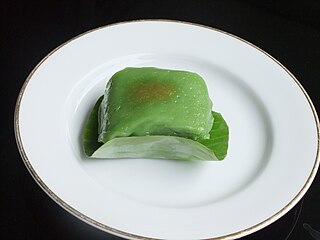
Kue bugis is Indonesian kue or traditional snack of soft glutinous rice flour cake, filled with sweet grated coconut. The name is suggested to be related to Bugis ethnic group of South Sulawesi as their traditional delicacy, and it is originated from Makassar. In Java the almost identical kue is called kue mendut. Kue bugis, together with kue lapis and nagasari are among popular kue or Indonesian traditional sweet snacks, commonly found in Indonesian traditional marketplace as jajan pasar.
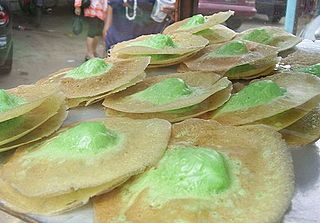
Kue ape or serabi Jakarta is a popular traditional kue pancake with soft and fluffy center surrounded with thin and crispy crepes, commonly found as a popular street food in Indonesia, especially in Jakarta and other major cities. It is also popularly known as kue cucur tipis, which is different from the thicker kue cucur, and colloquially known as kue tetek due to its shape that resembles a nipple. Because it is deemed inappropriate to say ‘tetek’, most Indonesians just say kue ape as in “what cake?”. It is also very similar to serabi Solo.

Kue mangkok, kue mangkuk is an Indonesian kue or traditional snack of steamed cupcake. kue mangkok means "bowl/cup cake". It is similar to the snack bolu kukus. While both have a similar appearance, Bolu Kukus requires only four ingredients to make, Kue Mangkok needs fourteen. The result is a different taste. Bolu Kukus is soft and fluffy, on the contrary Kue Mangkok has a rough texture. Both are delicious snacks.

Dadar gulung is a popular traditional kue of sweet coconut pancake. It is often described as an Indonesian coconut pancake.
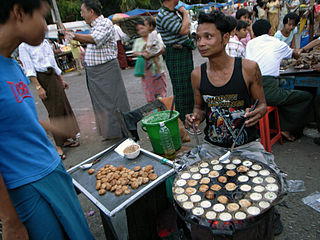
In the Burmese language, the term mont translates to "snack", and refers to a wide variety of prepared foods, ranging from sweet desserts to savory food items that may be cooked by steaming, baking, frying, deep-frying, or boiling. Foods made from wheat or rice flour are generally called mont, but the term may also refer to certain varieties of noodle dishes, such as mohinga.

Kue rangi or also called sagu rangi is an Indonesian coconut kue or traditional snack made of a coconut and starch-based batter and cooked in a special molded pan. It is one of the traditional Betawi snack of Jakarta. Kue rangi often described as Indonesian coconut waffle.

Kue pancong, kue pancung, bandros or gandos is an Indonesian kue or traditional snack made of a rice flour and coconut-based batter and cooked in a special mold pan. It is a commonly found snack in Indonesian traditional markets. Kue pancong is usually associated with Betawi cuisine of Jakarta, while bandros and often associated with Sundanese cuisine of Bandung city, although both refer to the same coconut hot cake.

Kue talam is an Indonesian kue or traditional steamed snack made of a rice flour, coconut milk and other ingredients in a mold pan called talam which means "tray" in Indonesian. The cake mold used to create kue talam are either larger rectangular aluminium tray or smaller singular cups made from ceramics, aluminium, melamine or plastic.

Indo cuisine is a fusion cooking and cuisine tradition, mainly existing in Indonesia and the Netherlands, as well as Belgium, South Africa and Suriname. This cuisine characterized of fusion cuisine that consists of original Indonesian cuisine with Eurasian-influences—mainly Dutch, also Portuguese, Spanish and British—and vice versa. Nowaday, not only Indo people who consume Indo cuisine, but also Indonesians and Dutch people.

























